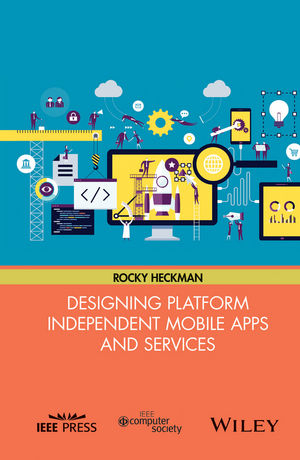
Designing Platform Independent Mobile Apps and Services
Wiley-Blackwell (Verlag)
978-1-119-06014-7 (ISBN)
Provides development patterns for platform agnostic app development and technologies
Includes recommended standards and structures for easy adoption
Covers portable and modular back-end architectures to support service agility and rapid development
Rocky Heckman works for Microsoft Corporation. He acts as an architectural advisor and technical consultant to Microsoft's partners and customers on the topics of HoloLens, Windows Azure, Windows 10 Universal Apps, and SQL server. He received his bachelor's degree in software engineering at the University of Canberra, Australia, and certification in C++ programming, object-oriented programming, and project management at the Colorado Technical University.
LIST OF FIGURES xi
LIST OF TABLES xiii
PREFACE xv
ACKNOWLEDGMENTS xvii
CHAPTER 1 THE MOBILE LANDSCAPE 1
1.1 Introduction 1
1.2 Previous Attempts at Cross-Platform 2
1.2.1 Java 2
1.2.2 Early Web Apps 5
1.2.3 Multiple Codebases 7
1.3 Breadth Versus Depth 9
1.4 The Multi-Platform Targets 10
1.4.1 Traditional 10
1.4.2 Mobile 11
1.4.3 Wearables 12
1.4.4 Embedded 13
CHAPTER 2 PLATFORM-INDEPENDENT DEVELOPMENT TECHNOLOGIES 15
The Golden Rule 15
2.1 Vendor Lock-In 16
2.2 Recommended Standards and Guidelines 18
2.2.1 Respecting the Device 18
2.2.2 Respecting the Network 19
2.2.3 Communication Protocols 21
2.2.4 Data Formats 31
2.2.5 Mobile User Experience Guidelines 40
2.2.6 Authentication 45
2.2.7 Dealing with Offline and Partially Connected Devices 47
2.3 Wrapping Up 63
CHAPTER 3 PLATFORM-INDEPENDENT DEVELOPMENT STRATEGY 64
3.1 High-Level App Development Flow 64
3.2 Five-Layer Architecture 65
3.3 Five-Layer Architecture Detail 66
3.3.1 The User Interface Layer 66
3.3.2 The Service Interface Layer 68
3.3.3 The Service Layer 69
3.3.4 The Data Abstraction Layer 70
3.3.5 The Data Layer 70
CHAPTER 4 THE USER INTERFACE LAYER 72
4.1 Porting Versus Wrapping 72
4.2 Multi-Client Development Tools 73
4.2.1 PhoneGap (http://phonegap.com/) 73
4.2.2 Xamarin (http://xamarin.com/) 74
4.2.3 Unity (http://www.unity3d.com) 75
4.2.4 Visual Studio 76
4.3 Cross-Platform Languages 76
4.4 Avoid Writing for the Least Common Denominator 77
4.5 Wrapping Up 78
CHAPTER 5 THE SERVICE INTERFACE LAYER 79
5.1 Message Processing 79
5.1.1 Push versus Pull 80
5.1.2 Partially Connected Scenarios 81
5.2 Message Processing Patterns 82
5.3 High-Volume Messaging Patterns 85
5.3.1 Queue Services and Microsoft Azure Event Hubs 86
5.3.2 Web Sockets 89
5.4 High-Volume Push Notifications 91
5.4.1 Third Party Notification Hubs 93
5.5 Message Translation and Routing 97
5.5.1 Message Translation 97
5.5.2 Message Routing 103
5.5.3 Handling Large Amounts of Data 108
5.6 Wrapping Up 111
CHAPTER 6 THE SERVICE LAYER 114
6.1 Thinking in Nodes 114
6.1.1 Scale Out and Scale Up 114
6.1.2 Scale Out versus Scale Up 114
6.2 Planning for Horizontal Scaling 117
6.2.1 Node Sizing 117
6.2.2 Statelessness 120
6.3 Designing Service Layers for Mobile Computing 121
6.3.1 Service Componentization 122
6.4 Implementation Abstraction 124
6.4.1 Service Interface Abstraction 124
6.5 Using CQRS/ES for Service Implementation 127
6.5.1 CQRS Overview 127
6.5.2 Why CQRS 129
6.5.3 Being Able to Separate Data Models 129
6.5.4 Aggregates and Bounded Contexts 131
6.5.5 The Read and Write Sides 132
6.5.6 CQRS Communications 132
6.6 Side by Side Multi-Versioning 140
6.7 Service Agility 141
6.8 Consumer, Business, and Partner Services 141
6.9 Portable and Modular Service Architectures 142
6.9.1 Designing Pluggable Services 145
6.9.2 Swapping Services 147
6.9.3 Deployment and Hosting Strategies 151
6.10 Wrapping up 152
CHAPTER 7 THE DATA ABSTRACTION LAYER 154
7.1 Objects to Data 154
7.2 Using the DAL with External Services 157
7.3 Components of a DAL 159
7.3.1 Data Mapper 160
7.3.2 Query Mapper 161
7.3.3 Repository 166
7.3.4 Serializers 168
7.3.5 Storage Consideration 169
7.3.6 Cache 172
7.4 Wrapping Up 174
CHAPTER 8 THE DATA LAYER 176
8.1 Overview 177
8.2 Business Rules in the Data Layer 178
8.3 Relational Databases 178
8.4 NoSQL Databases 181
8.4.1 Key Value Database 183
8.4.2 Document Database 186
8.4.3 Column Family Databases 189
8.4.4 Graph Database 194
8.4.5 How to Choose? 197
8.5 File Storage 197
8.6 Blended Approach 200
8.6.1 The Polyglot Data Layer 201
8.7 Wrapping up 203
CHAPTER 9 STRATEGIES FOR ONGOING IMPROVEMENT 204
9.1 Feature Expansion 204
9.1.1 User Interface 206
9.1.2 Service Interface Layer 206
9.1.3 Service Layer 206
9.1.4 Data Abstraction Layer 206
9.1.5 Data Layer 207
9.2 Data Collection Matters 207
9.3 Multi-Versioning 209
9.4 Version Retirement 212
9.4.1 Scale Back 214
9.5 Client Upgrades 216
9.6 Wrapping Up 220
CHAPTER 10 CONCLUSION 221
REFERENCES 225
INDEX 229
| Verlagsort | Hoboken |
|---|---|
| Sprache | englisch |
| Maße | 155 x 236 mm |
| Gewicht | 499 g |
| Themenwelt | Informatik ► Software Entwicklung ► Mobile- / App-Entwicklung |
| Informatik ► Weitere Themen ► Smartphones / Tablets | |
| Technik ► Elektrotechnik / Energietechnik | |
| ISBN-10 | 1-119-06014-1 / 1119060141 |
| ISBN-13 | 978-1-119-06014-7 / 9781119060147 |
| Zustand | Neuware |
| Haben Sie eine Frage zum Produkt? |
aus dem Bereich


